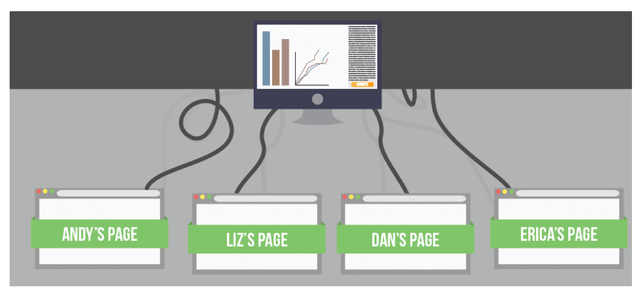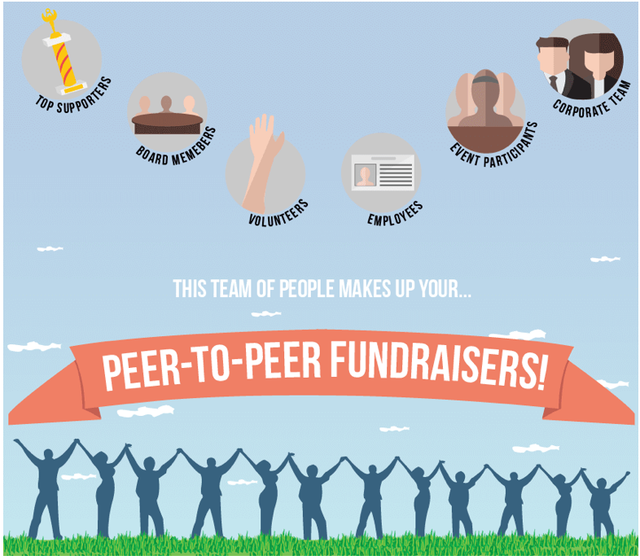Peer-to-Peer Fundraising: a mini guide for nonprofits
Peer-to-peer fundraising could raise huge amounts of income but running a campaign can often seem overwhelming. Check out this guide to start off on the right foot.
- Written by
- Dan Quirk
- Added
- April 26, 2018
If you’re looking to dramatically increase your nonprofit organisation’s donation revenue this year, you’re probably considering the idea of hosting a peer-to-peer campaign.
Because a peer-to-peer fundraising campaign involves recruiting multiple individual fundraisers who will raise funds from lots more people via their social networks at once, they can often seem a bit overwhelming to organise.
From signing up your peer-to-peer fundraisers to the online support pages, if you stick to this simple plan, you won’t have to worry about a thing.
This article will cover all the basics:
What is peer-to-peer fundraising?
Who uses peer-to-peer fundraising?
How does peer-to-peer fundraising work?
Why should my nonprofit host a peer-to-peer fundraising campaign?
What events can I host in conjunction with a peer-to-peer campaign?
What are some best practices for peer-to-peer campaigns?
How do I get started on my peer-to-peer fundraising campaign?
Before we dive in, take a look at this peer-to-peer fundraising infographic for a quick rundown.
1. What is peer-to-peer fundraising?
Peer-to-peer fundraising is a type of fundraising campaign in which a nonprofit asks their most passionate supporters to fundraise on behalf of the organisation. Peer-to-peer fundraising is different from other types of campaigns because the nonprofit’s supporters reach out to solicit donations from others instead of the supporters donating directly to the nonprofit themselves.
This way, the organisation gains exposure and educates a wider audience about its cause as the supporters ask their individual social networks of family, friends and peers for donations.
Peer-to-peer fundraising is also known as P2P fundraising, DIY fundraising and social fundraising. It works well paired with crowdfunding, which is another online fundraising method.
2. Who uses peer-to-peer fundraising?
Because peer-to-peer fundraising can be so cost-effective, nonprofits of all different sizes rely on it for revenue. Even organisations such as churches and schools can use this fundraising method to improve their general and online donations.
The benefits from peer-to-peer fundraising campaigns are limitless, which is why many nonprofits with active supporters choose to host a peer-to-peer campaign.
3. How does peer-to-peer fundraising work?

We’ll break down how a typical peer-to-peer fundraising works in just a few steps. Keep in mind, any fundraising campaign relies heavily on good organisation. A peer-to-peer campaign is no exception. Your nonprofit has to ensure it has the proper infrastructure in place before launching this kind of campaign.
Create your goals and outline your campaign
Before you begin recruiting supporters to fundraise, or look into a peer-to-peer platform you’ll need to clearly define your goals and how your campaign should look. You should be able to answer the following questions concerning your campaign:
Will you have an opening event?
What is your monetary goal?
How many new supporters and donors are you expecting to have at the end of your campaign?
Will your campaign have a time frame or will it continue until your monetary goal is met?
Before you bring in other individuals, your nonprofit needs to know exactly what the campaign goals are.
Pick a platform and create your page
A peer-to-peer fundraising software will make your life much easier, allowing your fundraisers to create their own individual fundraising pages to collect online donations. (Don’t worry, we’ll help you out with selecting the right software provider and payment processor in just a minute.)
Creating your home page on your chosen platform is a crucial element in your campaign’s success. All of your individual fundraisers’ pages will link to your nonprofit’s main fundraising page on the platform. Think of it this way: while your fundraisers are out at first, second, and third bases and in the outfield, your main fundraising page is home base, where everyone returns eventually. For our non-American readers, these are baseball terms.
Your fundraising page should prominently show high quality videos and photos, followed by a brief yet powerful description about your cause and why this specific campaign is worth supporting. This will be where the peers of your individual fundraisers (and potential donors) get all their information about your nonprofit without going to your organisation's own website.
This page is also where you’ll promote your fundraising event, if you choose to host one.
Get your fundraisers excited
A peer-to-peer fundraising campaign is only as strong as its fundraisers, so you’ll need to make sure they’re just as excited as you are. Your team will most likely be made up of loyal donors, board members, previous volunteers and your staff.
As explained in this SOFII article, you’ll want to educate your fundraisers on your nonprofit, your cause and your campaign. Even if they’re already heavily involved with your organisation, refreshers never hurt.
You’ll also need to provide them with email templates and marketing materials to help them spread the word about your campaign and collect donations. Make sure they’re well versed in how your online donation process works – whether it’s on a desktop or mobile device.
Once the campaign begins and your fundraisers are off collecting donations, your work still isn’t over. You’ll need to be in constant contact with your fundraisers to make sure the campaign is running smoothly.
Many peer-to-peer software providers will even offer features to help you maintain contact with your fundraisers with automated emails and scheduled check-ins. In addition, your provider will most likely supply you with tools and metrics you can use to track your progress.
4. Why should my nonprofit host a peer-to-peer campaign?

Peer-to-peer fundraising campaigns are an easy way to engage your current supporters. By asking them for their help on behalf of your organisation, you’re providing a fun way for them to learn more about your cause.
Plus, by trusting them to fundraise on your behalf, you prove you value their support and involvement with your organisation.
In addition, these campaigns are an easy way to expand your donor base. With your supporters sharing your campaign with their personal networks both digitally and physically, your nonprofit is reaching individuals you never would have found on your own.
One of the many beneficial aspects of reaching so many new potential donors is that your organisation dramatically increases its amount of funds. With so many fundraisers and their respective networks, a peer-to-peer fundraising campaign is easy to launch and receive revenue from.
5. What events can I can host in conjunction with a peer-to-peer campaign?
If you’re thinking about hosting a fundraising event to kick off your peer-to-peer campaign (which we suggest you do), there are plenty of events to pick from.
It’s great if you find an event that’s related to your cause, but no matter what, you’ll want to choose a community event that most individuals can and will want to participate in.
Think about active events like an obstacle course or a 5K walk/run to get your community into some positive competition and spark the spirit for your campaign. These events will ultimately kick start your campaigns, getting both fundraisers and donors excited and informed about your cause.
6. What are some best practices for peer-to-peer campaigns?

There’s a lot to manage when it comes to a peer-to-peer fundraising campaign, so we’ll give you our best practices to help your campaign run smoothly.
Don’t leave any channels out
You can market across every platform possible. And you should. Email and social media are great methods, but don’t forget about direct mail and phone calls, too.
The more communication channels you use, the more potential donors you’ll reach and the more donations you’ll receive.
Share your story
Your donations will depend on how well you can communicate your nonprofit’s cause. If you can make a connection so that your potential donors feel the passion and importance of supporting your cause, you’re more likely to see more contributions.
Be sure to include how much your donors’ support helps you further your work by sharing testimonials from the communities you help, providing photos, or explaining what tangible results specific donation amounts will have!
Thank your fundraisers
You should always thank your fundraisers personally and publicly (if they’re comfortable with that). Highlighting top fundraisers on your social media will make sure they get the proper recognition they deserve for fundraising on behalf of your nonprofit.
After all, it’s all about optimising your supporters’ experiences because without them, you wouldn’t have a campaign.
7. How do I get started on my peer-to-peer fundraising campaign?
You’ll want to start shopping around for peer-to-peer fundraising software and thinking of which individuals to ask to fundraise for you.
As for the software, there are a few questions you should ask yourself while comparing different providers:
You’ll want software that can grow with your organisation and campaigns. Look for something that can handle your current and future needs (like number of users, number of fundraisers, or even customisation options).
Is this software in your budget? Needless to say, you’ll need to find a solution you can afford. Most software providers will charge an initial fee, but keep your eye out for any other fees that will be included, like transaction fees or training costs.
Will this software help track the campaign’s progress? Look for software that will provide you with tracking and reporting features so you can use these metrics to judge your progress, keeping your goal in mind.
Is this software secure? Because you’ll be accepting donations online, you’ll need to make sure your software is secure, specifically PCI compliant. Ask software providers about the security measures they take and the payment processors they use.
Is this software easy to use? In other words, will you need training? As previously mentioned, training may be an additional cost, so you’ll want to check out your provider’s demo to get a feel for the software before purchasing.
We know that a peer-to-peer fundraising campaign is no easy feat, but now that you have our mini guide, you’re well-prepared to host your most successful campaign yet. All that’s left to do is gather up your fundraisers and get started. Happy fundraising!

















